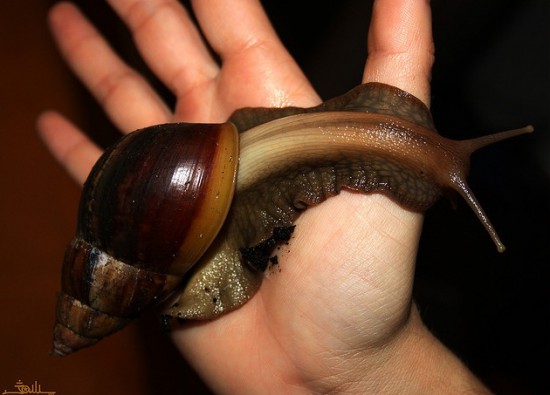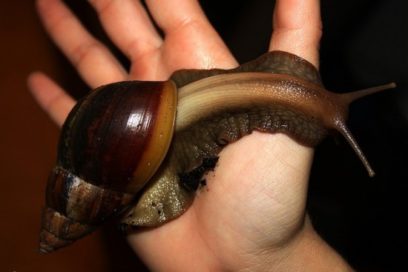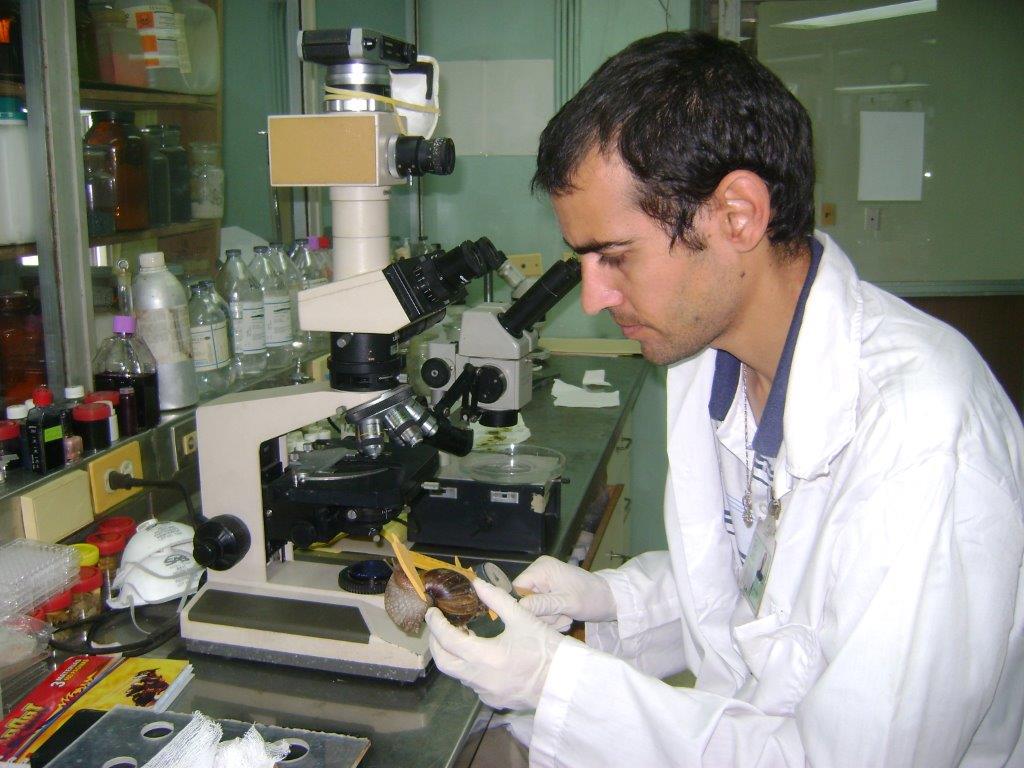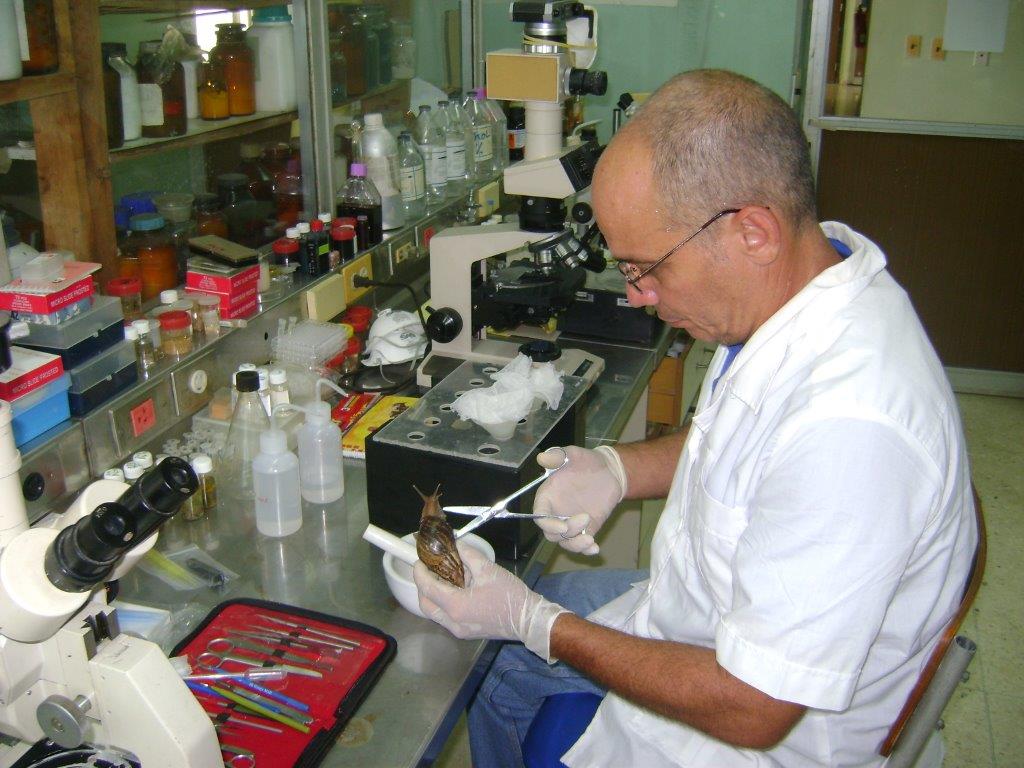 Cuban fauna is considered the most diverse worldwide with endemic characteristics that reach the 95 percent in its land’s representatives. This characteristic made the famed scientist Henry Pilsbry declare Cuba as the “Paradise of the zoologists” and it could be threatened by the introduction of an exotic specimen known a Giant African Nail.
Cuban fauna is considered the most diverse worldwide with endemic characteristics that reach the 95 percent in its land’s representatives. This characteristic made the famed scientist Henry Pilsbry declare Cuba as the “Paradise of the zoologists” and it could be threatened by the introduction of an exotic specimen known a Giant African Nail.
After collecting them in the field by researchers from the Zoology Lab from IPK (Pedro Kouri Institute) they verified the presence of the land mollusk specimen (Lissachatina fulica Bowdich 1822 (Mollusk Gastropoda: Achatinidae). They were found at Felipe Poey locality in Arroyo Naranjo municipality on July 2014. They verified the presence of a considerable number of L. fulica with medium size of 10 cm long of its nail mainly on trees and bushes. The young specimens were found on the ground near the vegetation. The maximum size they can reach is about 20 cm.
This specimen is originally from the African continent but was introduced almost all the planet for the following main reasons: (1) anthropological introduction for religious and therapeutic purposes (nail slime) as well as by plants’ marketing or as simple pets; and (2) natural introduction due to its high phonotypical plasticity, a strategy of reproduction (high fecundation and fertility, it can lay between 50 to 300 eggs six times a year) with high life expectancy (up to nine years). All these ecological characteristics turn this specimen into a high competitive one able to support its population and displace native specimens for competition in the exploitation of the resources (food and space). So it can be considered an invasive specimen that could bring unpleasant consequences on the autochthonous fauna and flora of Cuba. The origin of L. fulica is from the Eastern region of Africa, Indian Ocean and the Asian south eastern region. It started since mid 19th century and the beginning of the 20th. Its introduction in the Pacific Ocean seems to be linked to the Japanese activity in the II World War, and it is introduced in Hawaii in 1936. In South America and the West Indies it appears in 1980 while in the United States is informed in Florida for the first time in 1966. Its introduction in America is associated to the commerce of plants and food, where it can travel without been discovered, although it can also be for African religious purposes too.
L. fulica is included in the list of the 100 most invasive dangerous specimens worldwide according to the International Union for Nature Preservation. It is also considered the main vector in the world of Angiostrongylus cantonensis, which can cause Encephalic Meningitis in human beings.
This parasite that exists in Cuba since some decades ago which is transmitted by the majority of the native mollusks in Cuba, could increase its frequency of human transmission due to its greater compatibility with the new specimen introduced. In relation to its medical importance, the A. cantonensis is a parasite in its adult rodent state that uses the mollusks intermediate guests.
Human beings are infected accidentally when having direct contact with the larva in the third phase coming from the mollusks although the life circle of the parasite is not closed. In human beings it can cause Encephalic Meningitis which could be fatal if not treated on time. The problem with this specimen is that as it is the biggest it can have a greater quantity of A.
cantonensis larva.
Almost any of the specimens of this ground mollusk in Cuba can transmit this parasite; however, not all transmit it the same way. The problem is that L. fulica specimen seems to transmit very well this nematode and so, it increases the possibilities of infection in the population.
If we add to its biological characteristics of good guest, others like its easy reproduction, as well as some ecological ones like its capacity to be generalist in habitat and feeding, and its frequent competitive aptitude, the scenario could favor the transmissions of A. cantonensis by L. fulica. In fact, L. fulica is considered a health problem in many countries from South America for the transmission of this parasite, but mainly associated to its raw consumption or not well cooked, or the contact with its slime (that has the larva). The preliminary results with samples collected have revealed high infection with A. cantonensis.
All referred in non-scientific information with diarrhea diseases that try to associate this specimen has no sense: generally mollusks can be reservation of many micro organisms and virus that, in theory, could cause these events, but all mollusks existing before also could.
Zoology Lab from IPK is already doing the necessary investigations on this specimen in Cuban conditions to determine a plan to handle it.
Taken from the Tropical Medicine Institute “Pedro Kouri”




